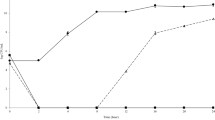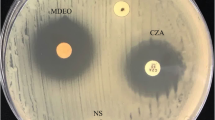Abstract
Intercellular communication is a crucial process for the multicellular community in both prokaryotes and eukaryotes. Indole has been recognized as a new member of the signal molecules which enables the regulated control of various bacterial phenotypes. To elucidate the inter-species relationship among enteric microorganisms via indole signaling, Klebsiella pneumoniae (KP) culture was treated with indole solution and examined for the pathogenicity by using various phenotypic tests. Both synthetic and naturally-produced indole preparations had no deteriorating effect on growth and autoaggregative capacity of KP. The results showed that biofilm formation of carbapenem-susceptible K. pneumoniae (KP-S) was clearly induced by indole exposure (≈ 2–10 folds), whereas no significant difference was observed in the resistant counterpart. In addition, the tolerance to β-lactam antibiotics of KP was altered upon exposure to indole and/or derivatives assessed by Kirby–Bauer disk diffusion test. Taken together, our finding indicates the functional role of indole in changing or modulating pathogenic behaviors of other bacteria.




Similar content being viewed by others
References
Ng WL, Bassler BL (2009) Bacterial quorum-sensing network architectures. Annu Rev Genet 43:197–222. https://doi.org/10.1146/annurev-genet-102108-134304
Rutherford ST, Bassler BL (2012) Bacterial quorum sensing: its role in virulence and possibilities for its control. Cold Spring Harb Perspect Med 2:a012427. https://doi.org/10.1101/cshperspect.a012427
Novick RP, Geisinger E (2008) Quorum sensing in staphylococci. Annu Rev Genet 42:541–564. https://doi.org/10.1146/annurev.genet.42.110807.091640
Papenfort K, Bassler BL (2016) Quorum sensing signal-response systems in Gram-negative bacteria. Nat Rev Microbiol 14:576–588. https://doi.org/10.1038/nrmicro.2016.89
Zhao X, Liu X, Xu X, Fu YV (2017) Microbe social skill: the cell-to-cell communication between microorganisms. Sci Bull 62:516–524. https://doi.org/10.1016/j.scib.2017.02.010
Lee JH, Lee J (2010) Indole as an intercellular signal in microbial communities. FEMS Microbiol Rev 34:426–444. https://doi.org/10.1111/j.1574-6976.2009.00204.x
Lee JH, Wood TK, Lee J (2015) Roles of indole as an interspecies and interkingdom signaling molecule. Trends Microbiol 23:707–718. https://doi.org/10.1016/j.tim.2015.08.001
Bansal T, Alaniz RC, Wood TK, Jayaraman A (2010) The bacterial signal indole increases epithelial-cell tight-junction resistance and attenuates indicators of inflammation. Proc Natl Acad Sci USA 107:228–233. https://doi.org/10.1073/pnas.0906112107
Sabag-Daigle A, Soares JA, Smith JN, Elmasry ME, Ahmer BM (2012) The acyl homoserine lactone receptor, SdiA, of Escherichia coli and Salmonella enterica serovar Typhimurium does not respond to indole. Appl Environ Microbiol 78:5424–5431. https://doi.org/10.1128/aem.00046-12
Lee J, Attila C, Cirillo SL, Cirillo JD, Wood TK (2009) Indole and 7-hydroxyindole diminish Pseudomonas aeruginosa virulence. Microb Biotechnol 2:75–90. https://doi.org/10.1111/j.1751-7915.2008.00061.x
Lee JH, Kim YG, Cho MH, Kim JA, Lee J (2012) 7-Fluoroindole as an antivirulence compound against Pseudomonas aeruginosa. FEMS Microbiol Lett 329:36–44. https://doi.org/10.1111/j.1574-6968.2012.02500.x
Lee JH, Cho HS, Kim Y, Kim JA, Banskota S, Cho MH, Lee J (2013) Indole and 7-benzyloxyindole attenuate the virulence of Staphylococcus aureus. Appl Microbiol Biotechnol 97:4543–4552. https://doi.org/10.1007/s00253-012-4674-z
Hu M, Zhang C, Mu Y, Shen Q, Feng Y (2010) Indole affects biofilm formation in bacteria. Indian J Microbiol 50:362–368. https://doi.org/10.1007/s12088-011-0142-1
Hendrikx T, Schnabl B (2019) Indoles: metabolites produced by intestinal bacteria capable of controlling liver disease manifestation. J Intern Med 286:32–40. https://doi.org/10.1111/joim.12892
Lamb AC, Federico-Perez RA, Xue Z-L (2015) Product in indole detection by Ehrlich’s reagent. Anal Biochem 484:21–23. https://doi.org/10.1016/j.ab.2015.04.033
Turner JM (1961) A new reagent for the assay of indole in the tryptophanase reaction. Biochem J 78:790–792
Djordjevic D, Wiedmann M, McLandsborough LA (2002) Microtiter plate assay for assessment of Listeria monocytogenes biofilm formation. Appl Environ Microbiol 68:2950. https://doi.org/10.1128/AEM.68.6.2950-2958.2002
Han TH, Lee J-H, Cho MH, Wood TK, Lee J (2011) Environmental factors affecting indole production in Escherichia coli. Res Microbiol 162:108–116. https://doi.org/10.1016/j.resmic.2010.11.005
Sorroche FG, Spesia MB, Zorreguieta Á, Giordano W (2012) A positive correlation between bacterial autoaggregation and biofilm formation in native Sinorhizobium meliloti isolates from Argentina. Appl Environ Microbiol 78:4092–4101. https://doi.org/10.1128/aem.07826-11
Abdel-Rhman SH, El-Mahdy AM, El-Mowafy M (2015) Effect of tyrosol and farnesol on virulence and antibiotic resistance of clinical isolates of Pseudomonas aeruginosa. Biomed Res Int 2015:456463. https://doi.org/10.1155/2015/456463
Haghjoo B, Lee LH, Habiba U, Tahir H, Olabi M, Chu T-C (2013) The synergistic effects of green tea polyphenols and antibiotics against potential pathogens. Adv Biosci Biotechnol 04:959–967. https://doi.org/10.4236/abb.2013.411127
Jabra-Rizk MA, Meiller TF, James CE, Shirtliff ME (2006) Effect of farnesol on Staphylococcus aureus biofilm formation and antimicrobial susceptibility. Antimicrob Agents Chemother 50:1463–1469. https://doi.org/10.1128/AAC.50.4.1463-1469.2006
Paramaporn R, Thunchanok Y, Pawina R, Pimonsri M-A, Varaporn V, Tansila N, Altered virulence of non indole-producing pathogenic bacteria by indole signaling. Songklanakarin J Sci Technol (in press)
Kim J, Hong H, Heo A, Park W (2013) Indole toxicity involves the inhibition of adenosine triphosphate production and protein folding in Pseudomonas putida. FEMS Microbiol Lett 343:89–99. https://doi.org/10.1111/1574-6968.12135
Lin G-H, Chen H-P, Shu H-Y (2015) Detoxification of indole by an indole-induced flavoprotein oxygenase from Acinetobacter baumannii. PLoS ONE 10:e0138798. https://doi.org/10.1371/journal.pone.0138798
Chant EL, Summers DK (2007) Indole signalling contributes to the stable maintenance of Escherichia coli multicopy plasmids. Mol Microbiol 63:35–43. https://doi.org/10.1111/j.1365-2958.2006.05481.x
Garbe TR, Kobayashi M, Yukawa H (2000) Indole-inducible proteins in bacteria suggest membrane and oxidant toxicity. Arch Microbiol 173:78–82
Hall-Stoodley L, Costerton JW, Stoodley P (2004) Bacterial biofilms: from the natural environment to infectious diseases. Nat Rev Microbiol 2:95–108. https://doi.org/10.1038/nrmicro821
Koo H, Allan RN, Howlin RP, Stoodley P, Hall-Stoodley L (2017) Targeting microbial biofilms: current and prospective therapeutic strategies. Nat Rev Microbiol 15:740. https://doi.org/10.1038/nrmicro.2017.99
Kumar A, Alam A, Rani M, Ehtesham NZ, Hasnain SE (2017) Biofilms: survival and defense strategy for pathogens. Int J Med Microbiol 307:481–489. https://doi.org/10.1016/j.ijmm.2017.09.016
Lee JH, Kim YG, Kim CJ, Lee JC, Cho MH, Lee J (2012) Indole-3-acetaldehyde from Rhodococcus sp. BFI 332 inhibits Escherichia coli O157:H7 biofilm formation. Appl Microbiol Biotechnol 96:1071–1078. https://doi.org/10.1007/s00253-012-3881-y
Tan L, Zhao F, Han Q, Zhao A, Malakar PK, Liu H, Pan Y, Zhao Y (2018) High correlation between structure development and chemical variation during biofilm formation by Vibrio parahaemolyticus. Front Microbiol 9:1881. https://doi.org/10.3389/fmicb.2018.01881
Wilson C, Lukowicz R, Merchant S, Valquier-Flynn H, Caballero J, Sandoval J, Okuom M, Huber C, Brooks TD, Wilson E, Clement B, Wentworth CD, Holmes AE (2017) Quantitative and qualitative assessment methods for biofilm growth: a mini-review. Res Rev J Eng Technol 6. http://www.rroij.com/open-access/quantitative-and-qualitative-assessment-methods-for-biofilm-growth-a-minireview-.pdf
Dorken G, Ferguson GP, French CE, Poon WCK (2012) Aggregation by depletion attraction in cultures of bacteria producing exopolysaccharide. J R Soc Interface 9:3490–3502. https://doi.org/10.1098/rsif.2012.0498
Mueller RS, Beyhan S, Saini SG, Yildiz FH, Bartlett DH (2009) Indole acts as an extracellular cue regulating gene expression in Vibrio cholerae. J Bacteriol 191:3504–3516. https://doi.org/10.1128/jb.01240-08
Nuidate T, Tansila N, Saengkerdsub S, Kongreung J, Bakkiyaraj D, Vuddhakul V (2016) Role of indole production on virulence of Vibrio cholerae using Galleria mellonella larvae model. Indian J Microbiol 56:368–374. https://doi.org/10.1007/s12088-016-0592-6
Kim J, Shin B, Park C, Park W (2017) Indole-induced activities of β-lactamase and efflux pump confer ampicillin resistance in Pseudomonas putida KT2440. Front Microbiol 8:433. https://doi.org/10.3389/fmicb.2017.00433
Molina-Santiago C, Daddaoua A, Fillet S, Duque E, Ramos JL (2014) Interspecies signalling: Pseudomonas putida efflux pump TtgGHI is activated by indole to increase antibiotic resistance. Environ Microbiol 16:1267–1281. https://doi.org/10.1111/1462-2920.12368
Nikaido E, Giraud E, Baucheron S, Yamasaki S, Wiedemann A, Okamoto K, Takagi T, Yamaguchi A, Cloeckaert A, Nishino K (2012) Effects of indole on drug resistance and virulence of Salmonella enterica serovar Typhimurium revealed by genome-wide analyses. Gut Pathog 4:5. https://doi.org/10.1186/1757-4749-4-5
Nikaido E, Shirosaka I, Yamaguchi A, Nishino K (2011) Regulation of the AcrAB multidrug efflux pump in Salmonella enterica serovar Typhimurium in response to indole and paraquat. Microbiology 157:648–655. https://doi.org/10.1099/mic.0.045757-0
Vega NM, Allison KR, Samuels AN, Klempner MS, Collins JJ (2013) Salmonella typhimurium intercepts Escherichia coli signaling to enhance antibiotic tolerance. Proc Natl Acad Sci USA 110:14420–14425. https://doi.org/10.1073/pnas.1308085110
Nikaido H, Pagès J-M (2012) Broad-specificity efflux pumps and their role in multidrug resistance of Gram-negative bacteria. FEMS Microbiol Rev 36:340–363. https://doi.org/10.1111/j.1574-6976.2011.00290.x
Zwama M, Yamaguchi A (2018) Molecular mechanisms of AcrB-mediated multidrug export. Res Microbiol 169:372–383. https://doi.org/10.1016/j.resmic.2018.05.005
Blair JMA, Cloeckaert A, Nishino K, Piddock LJV (2013) Alternative explanation for indole-induced antibiotic tolerance in Salmonella. Proc Natl Acad Sci USA 110:E4569. https://doi.org/10.1073/pnas.1318318110
Padilla E, Llobet E, Doménech-Sánchez A, Martínez-Martínez L, Bengoechea JA, Albertí S (2010) Klebsiella pneumoniae AcrAB efflux pump contributes to antimicrobial resistance and virulence. Antimicrob Agents Chemother 54:177–183. https://doi.org/10.1128/AAC.00715-09
Hirakawa H, Inazumi Y, Masaki T, Hirata T, Yamaguchi A (2005) Indole induces the expression of multidrug exporter genes in Escherichia coli. Mol Microbiol 55:1113–1126. https://doi.org/10.1111/j.1365-2958.2004.04449.x
Hidalgo-Romano B, Gollihar J, Brown SA, Whiteley M, Valenzuela E Jr, Kaplan HB, Wood TK, McLean RJ (2014) Indole inhibition of N-acylated homoserine lactone-mediated quorum signalling is widespread in Gram-negative bacteria. Microbiology 160:2464–2473. https://doi.org/10.1099/mic.0.081729-0
Kalia VC, Patel SKS, Kang YC, Lee J-K (2019) Quorum sensing inhibitors as antipathogens: biotechnological applications. Biotechnol Adv 37:68–90. https://doi.org/10.1016/j.biotechadv.2018.11.006
Lepri S, Buonerba F, Goracci L, Velilla I, Ruzziconi R, Schindler BD, Seo SM, Kaatz GW, Cruciani G (2016) Indole based weapons to fight antibiotic resistance: a structure–activity relationship study. J Med Chem 59:867–891. https://doi.org/10.1021/acs.jmedchem.5b01219
Acknowledgements
This work was financially supported by the research Grants from the Faculty of Medical Technology (Grant No. MET6204008S) and Prince of Songkla University (Grant No. MET601266S). Thanks to Prof. Dr. Robert S. Philips and Microbiology Unit, Department of Pathology, Faculty of Medicine, Prince of Songkla University for kindly providing an indole-negative E. coli [E. coli BL21(DE3) tn5:tnaA] and K. pneumoniae isolates, respectively.
Author information
Authors and Affiliations
Corresponding author
Ethics declarations
Conflict of interest
On behalf of all authors, the corresponding author states that there is no conflict of interest.
Additional information
Publisher's Note
Springer Nature remains neutral with regard to jurisdictional claims in published maps and institutional affiliations.
Rights and permissions
About this article
Cite this article
Yaikhan, T., Chuerboon, M., Tippayatham, N. et al. Indole and Derivatives Modulate Biofilm Formation and Antibiotic Tolerance of Klebsiella pneumoniae. Indian J Microbiol 59, 460–467 (2019). https://doi.org/10.1007/s12088-019-00830-0
Received:
Accepted:
Published:
Issue Date:
DOI: https://doi.org/10.1007/s12088-019-00830-0




